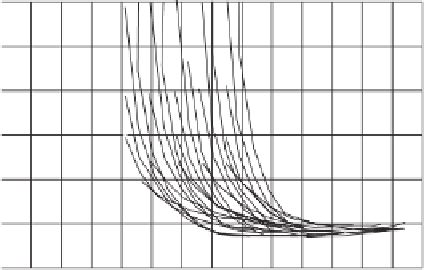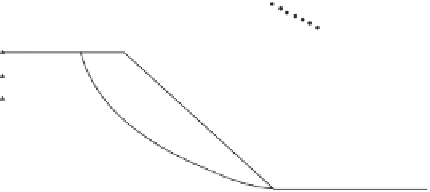Environmental Engineering Reference
In-Depth Information
4.0
3.5
0.901
Morgenstern-Price method
φ
'= 15
°
3.0
50
Radius = 52.8 m
x
= 65.6 m
y
= 58.7 m
40
2.5
-100 kPa
Solution for
φ
b
= 0
°
-50 kPa
0 kPa
30
2.0
g
= 18.0 kN/m
3
c
' = 10.0 kN/m
3
φ
20
1.5
+100 kPa
' = 34
°
10
1.0
+200 kPa
10
15
20
25
30
35
40
45
Radius, m
0
10
20
30
40
50
60
70
Distance, m
Figure 12.112
Factors of safety versus radius for all grid centers
for a relatively flat slope when negative pore-water pressures are
taken into consideration.
Figure 12.113
Location of critical slip surface on steep
slope when negative pore-water pressures are not
taken into
consideration.
Figure 12.112 shows a plot of the computed factors of
safety versus the radius of the slip surface. The character of
the results has changed dramatically from those shown for
the case when soil suction was ignored (Fig. 12.110). All
shallow slip surfaces show computed factors of safety going
beyond a magnitude of 4.0. Now there is no tendency for
a shallow slip surface to be computed as being the critical
slip surface.
A further analysis was performed with the
φ
b
value set to
25
◦
. The computed critical factor of safety increased to 1.35,
which was an increase of 5.3% over the case when matric
suctions were ignored. Quantifying the effect of negative
pore-water pressures is of value even in the case where a
relatively small portion of the slip surface lies above the
water table.
1.088
50
Radius = 41.5 m
x
= 53.2 m
y
= 50.8m
40
-100 kPa
Solution for
φ
b
= 15°
-50 kPa
0 kPa
30
g
= 18.0 kN/m
3
c
' = 10.0 kN/m
3
φ
20
+100 kPa
' = 34°
10
+200 kPa
0
10
20
30
40
50
60
70
Distance, m
12.7.4.3 Example 3 (Steep-Slope Case)
The steep slope in example 3 has an angle of 50
◦
to the
horizontal. Most of the slip surfaces pass above the water
table, which is on average 8m below the surface of the slope.
The unit weight of the soil is 18 kN/m
3
, the effective cohe-
sions is 10 kPa and the effective angle of internal friction
is 34
◦
. The geometry along with the critical slip surface is
shown in Fig. 12.113. The calculatedminimumfactor of safety
was 0.901 when negative pore-water pressures were ignored.
Figure 12.114 shows the location of the critical slip surface
and the minimum factor of safety when the
φ
b
value is 15
◦
and the negative pore-water pressures are taken into consid-
eration. The minimum factor is now 1.088, or an increase of
20.3%. The critical slip surface went considerably deeper into
the slope.
Increasing the
φ
b
angle to 25
◦
increased the minimum fac-
tor of safety to 1.170 (i.e., an increase of 29.6% over the case
where the pore-water pressures were ignored). The influence
of matric suction is more pronounced on steep slopes than
on the flatter slope. There is merit in quantifying the effect
of negative pore-water pressures on the change in factor
Figure 12.114
Location of critical slip surface for steep slope
when negative pore-water pressures are taken into consideration.
of safety and the change in the location of the critical slip
surface even when negative pore-water pressures may not
be relied upon in the engineering design. It is quite possible
that the slope stability analysis may lead to consideration of
advantages that can be accrued from protection against the
infiltration of water into a slope.
12.8 HAZARD ASSESSMENT AND DECISION
ANALYSIS RELATED TO SLOPE INSTABILITY
Slope instability is a hazard that is commonly triggered
by adverse weather conditions at ground surface. The soils
near the ground surface are often unsaturated, and as a
result, these soils have considerable water storage and may
also have a reduced hydraulic conductivity. Figure 12.115
shows a typical embankment subjected to varying climatic
conditions along with the various components that must


































































































































































































Search WWH ::

Custom Search